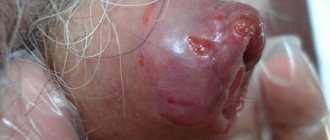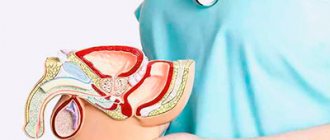What points should you pay attention to when choosing a medical institution and surgeon?
Depending on the location of the opening of the urinary canal, hypospadias is usually divided into:
- hypospadias of the penis;
- scrotal hypospadias;
- scrotal-perineal.
Penile hypospadias in children, in turn, is divided into the following forms:
- capitate;
- coronal;
- stem;
- penis-scrotum.
With capitate hypospadias, the opening of the urethra opens slightly below where it should normally be.
With this form of pathology, boys, as a rule, do not experience any discomfort when urinating, and the penis almost does not bend.
In most cases, surgical treatment is not used . Plastic surgery is used only if the external opening of the urethra is narrowed.
It is worth noting that boys with capitate hypospadias have an increased risk of developing specific forms of urethritis or genital warts . Some patients noted a disturbance in the act of urination, a decrease in the stream of urine or splashing, some had to urinate the female way (while squatting).
Naturally, such inconveniences can negatively affect the boy’s mental state . Such children are usually withdrawn, forcedly alienated from their peers. When they come to the clinic, they avoid other patients and prefer to discuss their problem alone with the doctor.
If we talk about a child in his first years of life, he is no different from his peers and may look absolutely healthy. In adolescence, during puberty, boys in some cases may experience problems with erection, and may also experience incomplete sexual sensations.
Symptoms
There are several signs of hypospadias in a child.
- With the disease, the external opening of the urethra is shifted to the side, and is not located at the top of the head of the penis. It may be located in the area of the coronary sulcus, shaft of the penis, scrotum or perineum.
- Almost always the pathology is noticeable visually. The doctor determines the degree of curvature during an erection or during surgery when performing an “artificial erection” test.
- The patient has dysplasia of the foreskin. The prepuce is split, located on top of the penis, hanging over in the form of a “hood”.
Often, congenital curvature of the penis is combined with other anomalies of the development of the genital organs: inguinal hernia, cryptorchidism, hydronephrosis, and so on. Before treatment, the child must have an ultrasound of the kidneys and bladder. Diagnostics will help to identify concomitant pathologies of the urinary system.
Diagnosis of hypospadias
Hypospadias should be diagnosed at birth (unless there is a giant urethral meatus with an intact foreskin). When diagnosing, it is necessary to indicate local changes.
• Position, surface and width of the urethral opening.
• Presence of urethral atresia and separation of the corpus spongiosum.
• Appearance of the skin covering the foreskin and scrotum.
• Penis size.
• Curving of the penis during erection. The diagnostic examination also evaluates associated disorders, including:
• cryptorchidism;
• open processus vaginalis or inguinal hernia (in 9–15% of cases).
Severe hypospadias with unilateral or bilateral non-palpable testicles or with suspected pathology of the genital organs require a complete genetic and endocrinological examination immediately after birth (to exclude disorders of sexual differentiation, especially congenital adrenal hyperplasia). Separation of urine dropwise and swelling of the urethra with fluid require the exclusion of stenosis of the urethral opening. The prevalence of upper urinary tract anomalies (UTA) does not differ from that found in the population, with the exception of very severe forms of hypospadias.
Treatment of hypospadias
To make a decision, it is important to separate functionally necessary and aesthetically justified procedures.
The functional indications for surgery are as follows.
• Proximally located opening of the urethra.
• Ventral deviation of the urine stream.
• Stenosis of the urethral opening.
• Curvature of the penis.
Cosmetic indications related to the psychological characteristics of the parents and the future of the patient are as follows.
• Pathologically located opening of the urethra.
• Splitting of the head.
• Rotation of the penis with pathological placement of the skin flap.
• The type of skin covering the foreskin.
• Transposition of the penis and scrotum.
• Splitting of the scrotum.
Because all surgical procedures carry a risk of complications, detailed preoperative parental counseling is essential.
Video: https://www.pedurology.ru/chto-i-kak-my-lechim/video-detskaya-urologiya/36-gipospadiya-uretroplastika.html
Treatment Goals
If possible, correct the curvature of the penis, form a new urethra of adequate size, bring the new opening of the urethra to the tip of the head of the penis and achieve an overall good cosmetic result. It is necessary to use magnifying glasses and special thin synthetic absorbable suture materials (6/0–7/0). For small penis sizes and for repeated operations for hypospadias in the preoperative period, it is advisable to carry out hormonal therapy using local or parenteral administration of testosterone, dihydrotestosterone, beta-chorionic gonadotropin.
Age of operation
Typically, surgical treatment of primary hypospadias is performed at the age of 10–24 months. However, earlier reconstruction at 6 months of age has recently been described. in some cases.
Curvature of the penis, hypospadias of the chord type.
If there is a curvature of the penis, it can usually be corrected by exposing the penis (from the cutaneous chordae) and excision of the connective tissue of the true chordae on the ventral surface of the penis. The urethral plate contains connective tissue with a large number of vessels, and in many cases does not cause curvature. Residual chordae (curvature) are caused by disproportion of the corpora cavernosa, and when they are identified, the penis must be straightened, mainly with the help of dorsal ortoplasty (a modification of the method of dorsal orthoplasty of the cavernous bodies (Nesbitt procedure)).
Rice. Chord type hypospadias (hypospadias without hypospadias)
Preservation of a richly vascularized urethral plate
The basis of hypospadias repair in children is the preservation of a well-supplied urethral plate. Its use for urethral reconstruction has become the basis for the correction of hypospadias. If the urethral plate is wide, it can be rolled into a tube using the Thiersch-Duplay method. If the lamina is too narrow, a midline incision is recommended for folding, causing relaxation, followed by Snodgrass-Orkiszewski reconstruction for both distal and proximal hypospadias (although the latter has a higher complication rate). For proximal hypospadias and a pathological condition or insufficient width of the plate, it is preferable to use the onlay method. For distal forms of hypospadias, there are a number of other methods (for example, the Mathieu method, urethral lengthening, etc.
Causes of the disease
The nature of urethritis in children can be infectious or non-infectious.
Infectious sources of the disease:
- Staphylococcus;
- streptococcus;
- coli;
- herpes;
- ureaplasma;
- Trichomonas;
- gonococci and others.
Non-infectious factors in the development of urethritis:
- anatomical abnormalities of the urinary tract;
- hypothermia;
- violation of personal hygiene rules;
- wearing tight clothes;
- trauma to the urethra due to medical procedures (catheterization), falls, passage of stones, etc.;
- allergic reactions to foods, medications, detergents and other substances.
A sedentary lifestyle, which leads to congestion in the pelvis, can also become an impetus for the development of urethritis in children.
Treatment
The only effective treatment for congenital curvature of the penis in a child is surgery. It is aimed at:
- elimination of curvature of the cavernous bodies,
- formation of the missing section of the urethra,
- creating a normally located opening of the urethra,
- elimination of all cosmetic defects.
According to experts, the optimal age for surgery is from 6 months to 2 years. After surgery, sexual function is not impaired.
Specialists at the Andrologist03 clinic use various surgical methods to eliminate penile curvature in children. Surgeons have extensive experience and do everything possible to avoid complications and achieve excellent functional and cosmetic results. For more information please call.
Curvature of the penis in a child is a common pathology in the practice of a pediatric andrologist. It can be either congenital or acquired as a result of injury. It can manifest itself from the first days of a child’s life and intensify during adolescence, when the boy’s body experiences a physiological and psychological transition from childhood to adulthood.
What to do if your penis is crooked
Hello, Doctor! Over the past 2 months I have noticed that my penis has become bent. When it hangs and is calm, the penis is straight. And when he gets up before sex, he bends to the side. I also noticed that some kind of lump had appeared under the skin, but it didn’t hurt and didn’t bother me at all. I'm very worried. What should I do? Why is my penis crooked?
Misha, Moscow
Dear Mikhail!
Unfortunately, the symptoms indicated in your letter may indicate such an unpleasant disease as fibroplastic induration of the penis ( Peyronie's disease ).
The main cause of Peyronie's disease is damage to the erect penis , which results in rupture and subsequent healing of the tunica albuginea of the corpora cavernosa. Healing leads to the asymmetrical formation of plaques and scars, which, during erection, bend and deform the phallus, causing pain.
Sometimes the bends reach a right angle.
In addition to injuries, the development of the disease is facilitated by previously suffered syphilis, gonorrhea, tuberculosis, chronic torpid infections of the urethra, collagenosis, metabolic disorders, endocrine diseases in the pituitary-adrenal system, homosexuality, sexually transmitted infections (STIs, sexually transmitted diseases).
Peyronie's disease begins unnoticed and develops slowly, so men pay attention to it only when there is a decrease in the plasticity of the penis, most often expressed by a gradual but increasing curvature at the time of erection.
Curvature of the penis is observed in the direction corresponding to the larger lesion. At the same time, when areas of the cavernous bodies become denser, ejaculation becomes painful and difficult.
Upon palpation of the penis, a flat node of a round shape or in the form of an elongated plate with clearly defined boundaries is determined, painless, located semi-mobile in nearby tissues, having the hardness of cartilage. The skin is not changed. Outside of erection, pain is not observed. As the process progresses, it can cover up to 80% of the cavernous bodies.
At the onset of the disease, sexual function is preserved, but as the disease progresses, greater problems with sexual intercourse gradually occur, and anatomical erectile dysfunction (impotence) develops.
Fortunately, Sarklinik Saratov provides treatment for Peyronie's disease (fibroplastic induration of the penis) in Saratov, Russia.
Sarklinik wishes you a straight penis and an active sex life.
Sign up for a consultation. There are contraindications. Specialist consultation is required.
Related posts:
Enuresis at 62 years old, treatment in Saratov, Russia
Autism, alalia, agnosia, there is hearing, the child does not communicate, treatment
Unprotected sexual intercourse, discomfort in the testicle, spot, odor, short intercourse, yellow clots in semen
Treatment of cerebral palsy in Saratov, cerebral palsy
Masturbation, erection problems, cum quickly
Comments ()
Write a comment
Write a comment
Your email will not be published. Required fields are marked with *
Kinds
The disease is divided into types according to several factors.
Depending on the etiology:
- infectious specific - pathogens are gonococci, trichomonas, chlamydia, streptococci;
- infectious nonspecific is caused by enterococci, staphylococci, E. coli, protozoa;
- non-infectious develops as a result of injury to the urethra or allergies.
There are also two forms of infection based on the type of pathogen:
- gonorrheal - the causative agent is gonococci, transmitted sexually during early relationships or during childbirth from a sick mother to a baby;
- non-gonorrheal - caused by candida, trichomonas, chlamydia and other bacteria.
Based on the localization of the inflammatory process, three types are distinguished:
- anterior – with damage to the anterior wall of the urethra;
- posterior – the posterior wall of the canal is inflamed;
- total - the inflammatory process has spread to the entire urethra.
According to the course of the disease and clinical picture:
- acute form - lasts 10-12 days, has vivid symptoms;
- chronic form - develops two weeks after the onset of the disease and is a consequence of the lack of treatment for the acute stage, causing serious complications.
Only a doctor can determine the type of urethritis, based on the clinical picture of the disease and test results.
Price and cost of surgery for stem form of hypospadias in children
| Service | Price |
| Surgical treatment of hypospadias of the stem form of I category of complexity | 83000 |
| Surgical treatment of hypospadias of the stem form of II category of complexity | 123000 |
| Surgical treatment of hypospadias of the stem form III category of complexity | 185000 |
| Surgical treatment of hypospadias of the stem form IV category of complexity | 228000 |
The price list published on the website is not a public offer agreement. The provision of services is carried out on the basis of an agreement for the provision of medical services. We ask you to check the cost of services with your attending physician in advance.
The cost of the operation includes (no additional payment for services is necessary!):
- inpatient accommodation 1 day double room with all amenities
- preoperative tests
- disposable suture material Vicryl, PDS
- application of intradermal cosmetic suture
- disposable surgical consumables
- surgical instruments Ceatec GmbH Germany
- microsurgical instruments and equipment
- constant telephone communication with the attending physician
- examination any day in the clinic within 14 days after surgery
The cost of the operation does not include: anesthesia, additional diagnostics and treatment of concomitant diseases and their complications.
Anesthesiological support: anesthesiological apparatus Drager Fabius Plus (Germany), combined general anesthesia (inhalation anesthesia, caudal/local anesthesia).
** This is not a public offer agreement. Check the cost of services on the day of your request.
Our advantages
Experienced surgeons
Individual approach
Without pain and fear
Comfortable conditions
How to correct curvature during child development
It is believed that curvature of the penis in children can be corrected surgically. However, surgery in this delicate situation is actually plastic surgery, which requires a lot of strength and skill from doctors. What will it be like for a child who will have to go through a long - more than an hour and a half - operation and a long period of rehabilitation? Naturally, parents who are worried about their son’s health and want to see him as a confident man in the future are looking for a more gentle alternative to solving the problem.
Of course, in severe cases, surgery may indeed be inevitable. For example, surgeons are faced with a pathology of male genitalia - hypospadias, when a boy's penis in its appearance can resemble a clitoris, and the scrotum, even during the intrauterine development of the fetus, splits and becomes similar to the female labia. Such cases are explained by hormonal disorders and can only be corrected on the operating table, but, fortunately, they are rare. For congenital curvature of the penis, such aggressive intervention is usually not necessary: in this case, it is quite possible to limit oneself to alternative methods of correcting the shape of the penis. The Andro Ortez orthopedic device can be such a means of treating a crooked penis in a child.
Hypospadias is a fairly common developmental disorder in which the opening of the urinary canal is incorrectly located.
The disease occurs in the early stages of embryonic development .
The achievements of modern plastic surgery make it possible to treat abnormalities while preserving sexual and reproductive functions.
What are the different forms of hypospadias in newborn boys?
Patients with proximal forms of the disease, micropenia, or an impalpable testicle often require a special approach to treatment .
Such children may need to visit an endocrinologist, a geneticist, and conduct auxiliary examination methods to determine the karyotype to exclude violations of sex formation.
The following types of hypospadias are distinguished:
- Capitate - the opening of the urethra is on the head of the penis, but not in the standard place. This type of deviation is the most common. Basically the hole is just below the top of the head . Cases of curvature of the genital organ are rare.
- Coronary - the opening of the urethra is moved to the area of the coronary sulcus . The coronal type is characterized by disturbances in urination and the shape of the organ. Often when urinating, urine ends up on the legs.
- Stem - the opening of the canal is located on the underside of the genital organ . The penis is severely curved; in some cases, narrowing or stenosis of the urethral opening is detected. Patients have complaints about urination disorders, the flow is directed downwards, while the process in a standing position is significantly difficult, the curvature of the penis occurs with a turn to the side.
- Scrotal - the external exit of the urethra is concentrated in the scrotum area , the genital organ is small in size, in severe cases it looks like a clitoris. Emptying the bladder can only occur in a sitting position.
- Perineal - the external opening of the urethra looks like a wide funnel and is located in the perineal area , the penis is small and also strongly curved. The external opening of the urinary canal is extremely wide.
- Hypospadias of the chord type - the urine excretion channel is underdeveloped and short, its external opening is in a standard place , but the penis is deformed . There are embryonic scars around the canal, which increase the curvature of the corpora cavernosa. With excitement and during puberty, the violation of the form intensifies.
Pathology of the penis - curvature
Almost the entire human body is asymmetrical. For example, significant differences can be observed by examining the halves of the face. The same applies to arms, legs, paired internal organs.
The penis consists of cavernous bodies connected by a septum located along the midline of the body. Very often the corpora cavernosa are slightly different in size, which during erection will manifest itself as a slight curvature of the penis, mainly on the left. This condition is normal and does not require treatment.
A pathological condition is considered to be curvature of the penis, which interferes with sexual intercourse: makes it painful or prevents the penetration of the penis into the vagina. Curvature up to 30° does not have any clinical consequences and is therefore not considered a violation. In this case, urologists perform organ correction only at the insistent request of the patient.
The degree of penile curvature can be determined by causing the penis to become erect and measuring the angle of curvature.
Diagnostics
Most often, hypospadias is diagnosed immediately after birth during an examination by a neonatologist. In severe cases, an ultrasound examination of the genital area is performed to determine the sex of the newborn. Chromosome analysis is often required to establish an individual karyotype. After diagnosis, consultation with a genetic specialist is necessary, since hypospadias is a characteristic sign of many genetic abnormalities.
Subsequently, a urologist or pediatrician conducts an examination to determine the extent and nature of urinary disorders. Ultrasound examinations of the genitourinary system, uroflowmetry, and endoscopic examinations of the urethra can be performed.
Urine drainage and wound dressing
Urine is drained using a transurethral drip stent or through a drainage tube placed above the pubis. Some surgeons do not perform drainage after repair of distal hypospadias. It is common to apply a circular bandage with light pressure, as well as prescribe antibiotics for prophylactic purposes. The duration of stenting and bandaging varied significantly between studies. Due to the low level of evidence, no recommendation can be made.
By what signs can the disease be identified?
The main sign of deviation is the abnormal location of the opening of the emission canal . The existing disease significantly complicates the process of urination.
With the capitate type of deviation, male representatives have to lift their penis upward in order to direct the stream of urine in the desired direction.
Often, with hypospadias, the underformed urinary channel has narrowings that greatly complicate the process: the stream of urine is thin, intermittent, and the procedure itself requires tension in the abdominal muscles.
Depending on the type of deviation and location of the urinary canal, a boy may have structural abnormalities of the penis :
- curvature,
- absence of corpus spongiosum,
- underformation,
- split head, etc.
The lower the urethral opening is, the more pronounced other developmental disorders of the genital organs appear.
When complaining of pain in the organs of the urinary system, diagnostics often determine the rate of leukocytes in the urine, thanks to which many diseases can be identified. Hydrocalycosis of the kidneys is a common disease. Why the disease occurs and how to treat it, read our article.
Why does hypospadias occur?
The causes of hypospadias have not been identified.
According to doctors, the following reasons favor the development of this deviation:
- Heredity is the main factor in the development of the disorder. The risk of a boy having hypospadias is greater in a family where the father also had this disorder.
- Hormonal disruptions during the period of embryonic development of the fetus . Normal development of the penis and urinary canal occurs only if there is a sufficient amount of male hormones in the baby’s blood. The deficiency causes disturbances in the structure of the genital organ, undescended testicles, and hypospadias. That is why the disease is often accompanied by undescended testicles.
- Taking female hormones immediately before pregnancy or in its early stages increases the risk of having a baby with a deviation. For this reason, boys with a deviation more often appear in mothers who were treated for infertility or became pregnant through modern technologies.
Doctors have determined that hypospadias develops at the 10th week of fetal development , when the urethral tube is formed from the urethral groove, its parts are connected and when the cavernous bodies are formed.
The provoking reasons for the appearance of deviations include hormonal disruptions and genetic deviations in the pregnant woman’s body, and the environmental situation.
Also, causes of the disorder may include rubella, flu, and taking hormone-based medications.
Scientists are inclined to believe that hypospadias appears more often in a baby if the mother used hairspray .
Causes of stem-shaped hypospadias
The direct causes of the violation have not yet been identified. There are several provoking factors that can affect brainstem hypospadias and other forms of pathology:
- Gene mutations, genetic predisposition.
- Harmful effects of chemicals.
- Use of contraceptives with high estrogen content.
- Taking hormonal drugs during pregnancy.
- Multiple pregnancies or frequent births.
- Infections suffered in the first weeks of gestation.
- Mother's bad habits.
Don't waste your precious time - call!
Our specialists will be happy to answer all your questions
+7
Concomitant pathologies and complications with hypospadias
The disease can be combined with abnormalities of the genitourinary organs :
- undescended testicle,
- hernia in the groin,
- kidney disorders;
- also with violations of other organs and systems.
Hypospadias may result from more severe developmental defects of the reproductive system .
need gender reassignment in early childhood . An ill-chosen treatment approach ruins the lives of patients and provokes family problems.
Forecast
Modern techniques achieve positive results in approximately 80% of cases. In this case, it is possible to restore the desired appearance of the organ and functional abilities.
Early correction of the pathology guarantees normal development of the penis, as well as the exclusion of psychological trauma in the boy. After the operation, until the growth and formation of the penis is completed, such patients continue to be observed by a urologist.







